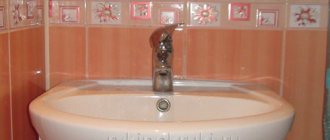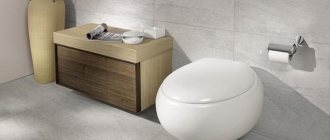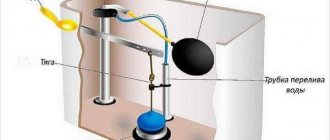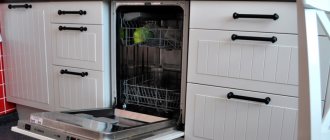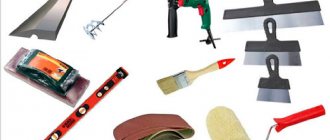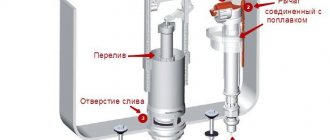A lovingly made renovation in the kitchen, carefully selected interior decor elements, beautiful dishes - in the morning you usually don’t want to leave your cozy nest. So you went out into the kitchen in the morning, prepared to make yourself a cup of coffee and some... What is that unpleasant smell coming from the sink? Let's let the water through - that's right, the water doesn't go away! Instead of morning bliss, we have a clog in the kitchen sink, what should we do, call a plumber or try to deal with it ourselves? The answers are in our article.
First, let us reassure you that most blockages can be eliminated on your own , without calling specialists. There are several methods; if in your case one of the selected options does not turn out to be effective enough, you can use another. Also, at the end of our article, we’ll talk about preventing clogs in the kitchen sink.
Preventing blockages
Preventive measures boil down to keeping out debris that is foreign to the pipes. It is easier to prevent blockages if it becomes a habit. Install a silicone mesh to catch hair and debris over the drain.
Its price is a little more than 100 rubles, and it saves remarkably from blockages. Here is a link to a trusted seller >>> And here is a link to a special chain that also collects hair and dirt; to clean the drain, you just need to remove it from the drain. It costs a penny. Read more >>>
- Install a special mesh with small holes in the drain hole. It won't hold everything, but a lot of debris remains on it.
- Carry out preventive cleaning from time to time using the following methods.
- Regularly – once a week, flush the pipes with boiling water. The volume of water is within 2-3 liters. This will wash away the soap scum deposits on the walls.
- When replacing pipes, check the correct angle of inclination.
Today there are a large number of chemicals on the market for clearing clogged pipes; after reading the instructions, you can choose what you need
Chemistry comes to the rescue
The choice of chemicals for cleaning sewer pipes is extensive - in any hardware department you will find something that you can afford.
The assortment is large - gels, granules, powders. In such chemical compositions, the active substance is either an alkali or an acid. Whatever you choose, the first thing you should take care of is your own safety.
Aggressive chemistry will not improve your health if you accidentally drop it onto your palm, so let's talk about precautions.
We open the windows, put on a protective mask and goggles, and wear thick rubber gloves on our hands. If the windows of your house face different sides and it is possible to provide cross ventilation, do it.
Never use two different cleaning chemicals at the same time, even with the best intentions - compounds can form that will harm not only the sewer system, but also you.
If you are a resident of an old housing stock with cast iron pipes, this method is not suitable for you. If you have plastic pipes, you should not increase the contact time of chemicals and elements of the sewer system prescribed by the manufacturer. By the way, the label should say that it is intended for your type of pipe.
If the blockage problem has been acute for quite a long time, perhaps one chemical filling will not be enough for you. Therefore, wait the allotted time (read the label), spill hot water and use the services of a trouble-free plunger. Together, both methods will definitely help you!
What if there are children and animals in the house? And you don’t want to use aggressive chemicals? Isn't there a more gentle way? There are such recipes, and we will definitely tell you about them.
Chemical cleaning methods
Various solutions and powders are used in cases where it was not possible to clean the drains with mechanical devices, or they are not at hand.
Patented drugs from the store or food solutions are used. Let's look at the most popular and best means for removing sewer blockages with your own hands.
Household chemicals
The most popular drain cleaners are:
- “Tiret” - available in gel form, copes with fat and food residues;
- “Bagi Pothan” - granules that remove hair, fur and limescale;
- "Mr. Muscle" - has the form of a gel or foam, dissolves hair and lime deposits.
After purchasing the drug, you should do the following:
- dry the pipeline with a rag or vacuum cleaner;
- fill the channel with a solution or powder and then add hot water;
- pause according to the instructions set out in the instructions;
- pour up to 1000 ml of boiling water into the neck.
Folk remedies
Let's look at some time-tested ways to get rid of sewer blockages.
- Salt and soda. You need to use one of these substances. The powder is poured into the drained drain, after which a glass of hot water is poured into it.
- Boiling water. Under the influence of high temperature, fat deposits dissolve and the pipe deforms. This leads to peeling and destruction of hard deposits.
- Vinegar. In large quantities, acid dissolves all organic matter. Using vinegar you can get rid of fur and hair.
How to clean mechanically?
Mechanical cleaning methods are often used to remove blockages . These include the use of a glass, a plunger or a special cable.
Plumbing cable
The cleaning cable is often metal. It has a handle on one side and a split, hard end for cleaning on the other.
Application:
- The working part is lowered into the drain.
- By turning the handle, the cable is moved along the drain pipe.
- After removing the cable from the drain, there may be debris at the end of the cable that is obstructing the passage of water.
- Repeat the procedure several times.
- Check the quality of cleaning by pouring water into the sink.
- If necessary, I repeat the processing.
Mechanical cleaning can be supplemented by using special chemicals or home recipes.
You can watch how to work with the cable in the following video:
Cup
For small blockages, when water passes through, but not as quickly as usual, even an ordinary glass can help.
Principle of operation:
- take some water into the sink;
- lower the glass so that it covers the drain hole;
- press and then sharply move your hand with the glass up;
- repeat several times.
Cleaning using this method is similar to the principle of using a plunger, but it will not help deal with serious blockages.
plunger
It is advisable to have a plunger in the household - a simple tool that will help deal with fresh blockages.
Procedure:
- fill the sink with some water;
- install the plunger so that the drain is completely covered with the working nozzle;
- press the plunger with force and pull it sharply towards you;
- repeat the treatment several times in a row, even if the plug has already been removed.
In addition to the usual plunger, you can use pneumatic models.
Removing blockages using improvised means
A plunger is one of the most common means at hand to combat this problem. Our great-grandfathers also used this miracle helper. Everyone probably knows how to use a plunger correctly, but it never hurts to brush up on your knowledge.
The plunger must be installed so that the hole in the bathroom is completely closed.
Next, you need to press the plunger handle several times. During the process, a stream of air enters the drain, which pushes the blockage.
Before using a plunger, it is better to initially pour hot water into the toilet.
This method allows you to cope with minor blockages. In addition, improvised means are used not only to remove blockages, but also to prevent them.
How to choose?
When purchasing a device, you must take into account the fact that a kitchen siphon cannot be installed in a bathroom. The wrong choice of plumbing parts will cause difficulties in using the drainage system.
Signs of a quality siphon:
- availability of certificates and permits;
- strict compliance with the type of sink and its individual characteristics;
- simplicity of design;
- availability of a complete set of parts;
- material of manufacture – plastic, stainless steel and brass;
- reasonable and adequate price;
- absence of mechanical damage and smooth surface;
- availability of high-quality threaded connections.
Modern technologies make it possible to independently cope with any type of household breakdown. Repairing and replacing a siphon is a simple process that can be carried out even by inexperienced craftsmen. Experts recommend not to wait for the device to become completely clogged, cracks to appear, or an unpleasant odor to appear. If the structure is leaking, appropriate measures must be taken immediately. Carrying out preventive measures will help to avoid problematic issues and significantly save the financial costs of purchasing a new siphon.
Preventing blockages in the bathroom
In order to prevent the formation of a plug in the drain system, follow the preventive measures:
- Carry out preventative cleaning every 2 weeks.
- Install a special fine mesh in the drain hole that will trap debris.
- After showering and washing your hair, remove hair to prevent it from ending up in the drain.
- Replace the pipes with plastic ones to avoid corrosion build-up and rust chips.
To prevent blockages, keep the bathtub clean, remove hair, avoid getting wool, threads, sand and other debris into the drain hole.
You can clear the blockage in the bathtub yourself, using improvised means or specialized household chemicals. After cleaning, follow the rules for using plumbing and carry out preventative cleaning to avoid recurrence of the problem or more serious troubles.
If the blockage is still not detected
If after completing all the procedures you see that the water is not draining well, but there is no blockage and you cannot find it, then the problem is not in your pipes. Perhaps this is a problem with the public sewer or the neighbor's. In this case, it is best to contact the staff of the utility service that services your home. They should send a technician to deal with the general sewer system.
Currently reading
- We repair chips on the bathtub with our own hands
- Installing faucets to an acrylic bathtub - easy with your own hands
- Simple reasons for hot water meters fogging
- We create a water leakage control system using improvised means
Effective methods for clearing sewer clogs
A good old plunger and cable.
These two things are found in almost every home. A plunger is a stick with a rubber tip shaped like a large suction cup that can suck out or push debris through.
Using this simple invention you can get the following results:
- Prevent the formation of blockages.
- Eliminate the causes of slow water drainage.
- Assess the scale of pollution.
Recommendations for using the plunger:
- Install the device so that its rubber part covers the drain hole.
- Draw a small amount of water into the bath (dry efficiency is reduced).
- Make a few pumps, moving the handle up and down.
- Check if the water is leaving.
- Rinse off the pumped out debris.
If this doesn’t help and the blockage in the bathroom still doesn’t go away, then what should you do? Use cable:
- Insert it into the drain hole.
- Push forward into the pipes and twist at the same time.
- When the voltage drops (the blockage is cleared), carefully move the cable back and forth.
- Remove and wash the product.
Chemicals
The modern chemical industry has taken care to make the process of removing blockages as fast and comfortable as possible.
Manufacturers are vying with each other to produce products for cleaning pipes from debris and deposits. The release form can be varied:
- powder;
- gel;
- liquid.
The most common and inexpensive remedy is Mole, a domestic product that perfectly removes odors, food and fat residues, and also breaks down fibers (hair, wool, etc.). Produced by different companies and may differ slightly:
- by composition;
- price;
- duration of action.
Compatibility with the type of pipes is usually indicated on the packaging. Here is a non-exhaustive list of effective drugs:
- Mister Muscle.
- Bugs.
- Pothan.
- Tiret.
- Floop.
- Mole.
Folk way to clear clogs: baking soda and vinegar
If you don’t have a plumber, a plunger, a cable, or purchased products at hand and the bathtub is clogged, it’s worth trying the folk method. To do this you will need:
- ½ cup baking soda;
- ½ cup vinegar;
- 1 liter of boiling water.
Follow these instructions:
- Wipe the tub and the metal drain ring dry.
- Pour baking soda into the drain hole.
- Pour vinegar in there.
- Pour in boiling water after 1 minute.
- After 2-3 minutes, turn on the water - it should flow freely.
Siphon cleaning
If you are still sure that the reason for the slow drainage of water is a necessary or valuable item, it is worth learning how to clean the siphon in the bathroom. This will make it possible to remove what got into the drain and caused the blockage.
Siphon cleaning technology:
- Lay a cloth under the siphon and place a basin or bucket.
- Slowly unscrew the closure nut to prevent liquid from gushing out.
- Remove the flask and drain the dirty water.
- Remove debris, small parts or lumps that are causing the problem.
- Rinse the siphon and remove plaque.
- Reinstall the siphon.
- Check the connections for tightness.
Now, if your bathtub suddenly becomes clogged, you will know what to do.
It is also worth watching a video on this topic:
Required Preparation and Tools
To fix a leak, you will need the following tools and materials:
- an adjustable wrench for loosening tight connections;
- new siphon or fittings;
- clamp;
- degreaser (white spirit, or nefras);
- sealant, if necessary - epoxy glue, cold welding;
- plumber's tape or tow (for leaking metal threads);
- liquid soap for lubricating gaskets;
- a bucket and dry rags to collect liquid.
To replace the section, you will need a grinder or a metal saw, a coupling and a new pipe 40-50 cm longer than the cut one.
Before you begin the repair, you need to perform several steps:
- Determine the location of the leak and, if possible, determine the cause of its occurrence. This will prevent problems during subsequent use.
- Shut off the water supply. If a leak is observed at the point of supply to the plumbing, then you can turn off the valve in 1 area. Otherwise, you will have to turn off the water in the apartment or throughout the riser. In the presence of cold water and domestic hot water, both supply valves are closed.
- If you couldn’t quickly turn off the water, wrap a section of pipe with a rag and lower its end into a wide basin. It is possible to repair a leak without draining the water only if the cause is minor corrosion damage.
- Disassemble the connection if necessary for repairs. Clean the siphon and adjacent pipes.
- If connections leak, check the threads and nut for cracks and replace the rubber gasket.
- Dry and degrease the repair area. Dirt and grease impair the adhesion of sealants, so the new connection will not be strong. When assembling plastic parts, do not use strong solvents, acids or acetone.
If the location of the damage is close to the common apartment valve (for example, near the meter), then after shutting off the hot water supply and hot water supply, you need to check whether the leak has stopped.
If liquid continues to collect on the pipe, then the entire riser must be disconnected for repair.
Cable
Plumbing cable is a thick twisted wire, rolled into a small spiral. For convenient rotation, there is a handle with a wooden or plastic attachment at the end.
This device is actively used to remove sewer blockages. Moreover, we are talking mainly about metal pipes.
Application:
The end of the cable must be carefully inserted into the drain hole.
It is best to do the work together. So, one person slowly rotates the handle, and the other carefully pushes the cable forward.
When the cable is twisted, accumulated debris is removed from the pipes, that is, the blockage is destroyed.
As soon as the tension in the pipes decreases, you need to pull the cable back and forth several times.
The cable is carefully removed, washed and stored.
If the procedure is ineffective, it is repeated.
Direct assembly
In most cases, sink drain parts are made of plastic, so you need to carry out all operations very carefully, because such threads can easily fail if you press on it a little harder. Such repairs do not help seal the joints, as a result of which the part will begin to leak.
A drain grate is fixed to the sink, which is secured from below and connects the device in question to the drainage device. The presence of two holes for drainage of liquid provides the basis for the installation of 2 siphons.
Scheme for cleaning a siphon with a tube.
When connecting household appliances such as a washing machine or dishwasher to this element, you can buy this part with several connectors.
The siphon is combined with a sewer pipe. First, the outlet part is disconnected, then it is fixed in the sewer pipe and screwed back. To better seal these parts, a rubber or plastic ring is used, the thickness of which is 15 mm.
When starting to seal the seams of the washbasin siphon, you should stock up on sealant. Sealing joints at toilets or urinals involves the use of a cement composition. During the installation process, it is necessary to monitor the integrity of the threads and gaskets. To check that the work was done correctly, you must turn on the water.
To improve the sealing of joints, many experts recommend wrapping tow or silicone tape around the threads.
The nut is put on tightly. After this, the thread is coated with paste and the part is screwed on. After running the water, you need to monitor the tightness of the joints for 3 minutes. The absence of leaks indicates the correctness of the work done.
Siphon cleaning
Male owners don’t think long about how to clear a clog in the bathroom. As a rule, they immediately begin cleaning the siphon. This procedure allows you to get rid of debris accumulated in pipes and unpleasant odors in the room.
Cleaning procedure:
On the floor directly under the siphon you need to lay a rag that absorbs moisture well.
Place a basin on top of the fabric. This simple measure will prevent dirty water from getting on the floor.
The bolt nut must be unscrewed very carefully. After this, you need to remove the flask.
Immediately after this, the water that formed the water seal will flow into the basin.
The siphon itself should be thoroughly rinsed with water and all plaque removed from the walls.
Such cleaning can also act as a preventive measure. For this purpose, the siphon is cleaned every 2-3 months.
Possible actions in case of siphon leakage
Modern plumbing units are predominantly made of plastic, so they can be easily disassembled, removed and replaced. Initially, you need to stop the water supply, find out the cause of the leak, and then decide on further actions.
If you discover that it is leaking under the sink precisely because of the siphon, you can take the following actions:
- Clean the sink, prepare a container for collecting water (it will need to be placed under the siphon itself before removing it), and rags. Additionally, you can fill the drain with detergent for plumbing. This will remove some of the dirt characteristic of sinks and dissolve grease.
- Diagnosis of the leak site. If an area of water accumulation is already visually visible, then you can immediately begin replacing or repairing the device. If you don’t know where the drains pass, you can insert a plug into the drain neck, after pumping out the liquid with a plunger, draw water into the sink, and then remove the plug. At this time, it is important to observe from which place the water is flowing;
- Removing the siphon. You need to be prepared that the element can be filled with a variety of dirt, some of which will immediately fall off after disconnection, so you should not forget about the container and rags prepared in advance. The plumbing product needs to be washed, inspected and the issue of replacement or repair decided.
This is interesting: Welding a profile pipe, which electrodes and inverter to weld thin-walled frames
Cleaning the siphon at home
If the cause of the blockage is in the siphon, you can clean it at home. It is worth noting that this cleaning is useful not only for blockages in the bathroom, but also for preventing the elimination of unpleasant odors.
On the surface under the siphon itself, you need to lay a rag that absorbs moisture well.
Place a bucket or basin on top of the rag. These things will protect your floor from excess water and thereby reduce the cleaning time afterwards.
Carefully unscrew the closure nut and remove the entire flask
Please note that water will flow out after opening the flask.
The siphon itself is washed with hot water, thereby thoroughly washing away any remaining debris.
Afterwards, return all the components to their places, the main thing is to make sure that the pipe does not rest against the siphon flask.
Open the water and check the parts for damage.
At home, this procedure is recommended as a preventative measure, about once every few months.
Technological process
Connection diagram for sinks and bathtubs to hot and cold water and sewerage pipelines.
Firstly, before carrying out the siphon repair procedure, you need to place some container under it so that water flows into it. If the siphon is leaking, then first of all you need to unscrew its lower part. Next, armed with a cable, wire or a long screwdriver, you need to clean it, freeing the surface from grease and dirty deposits. Next, this element is screwed into place, making sure that everything is in order with the sealing ring. Since rubber has the ability to deform, it is best to replace the old ring with a new one. Otherwise, after assembly, the siphon may leak in this place. Often, replacing the O-ring does not lead to the expected result. In this case, the connection between the siphon and the sump must be carefully treated with sealant.
During operation, such an important plumbing element must be regularly maintained. If you need to pour dirty water into the sink, you should install a strainer on the drain hole, which will prevent large particles from penetrating into the siphon.
The sink must be constantly used so that there is always water in the siphon. And since water evaporates quickly, if the sink is not used for a long time, it is recommended to pour oil or glycerin into it.
Thus, if the siphon model is selected correctly, it is installed according to all the rules and is provided with care, the service life of this equipment can be quite long.
What causes blockage
In most cases, a dense plug is formed due to small debris, clothing threads, hair, pet hair, and even pieces of soap getting into the drain pipe.
When you first encounter problems with your bathtub drain system, remember that there are three categories of blockages:
- Mechanical - caused by the accumulation of debris deposits.
- Operational - formed due to the lack of regular prevention.
- Man-made - associated with improper installation of the system, wear and tear of equipment and all kinds of gusts, accidents, leaks, etc.
If there is no blockage and the water outflow is weak, check the pipes. Perhaps the reason lies in the insufficient slope of the outlet pipe or in the small size of its cross-section. Increasing the slope of the drain pipe will eliminate the problem. Lower the socket of the sewer riser or raise the bathtub.
If you need to remove a blockage, use comprehensive methods to clean all pipes, including the sewer riser.
What does biogas consist of?
Most of the sewer system is an empty pipeline system. Inside it, any gases move easily and freely occupy the available volume. In private buildings, such independent structures are connected to settling tanks and special waste containers. Fermentation occurs there, the gradual decomposition of organic substances. With an excessive increase in gas volumes, the pressure in the entire sewer network rapidly increases. If it exceeds the permissible value, then gas enters the home. As a rule, this manifests itself in the same way: an unpleasant odor from the toilet, sink or bathtub, as well as gurgling sounds in the hydraulic valve.
The composition of biogas includes: methane, carbon dioxide, impurities of hydrogen sulfide, ammonia, nitrogen oxides, and other compounds. The first component occupies approximately 63% of the total volume, the rest are significantly less. Moreover, some of the latter are more harmful to health.
Biogas is formed during anaerobic (without air) methane fermentation of biomass Source strojdvor.ru
Causes of blockages
Causes of blockage: improper care of plumbing equipment and violation of the rules of its operation; which leads to the accumulation of debris, which clogs the lumen of the pipes, disrupts the drainage of water, and provokes the appearance of an unpleasant odor.
Mechanical cleaning, the use of commercial cleaning chemicals, as well as traditional methods will help get rid of the problem.
The most common cause of a clog in the sewer is the accumulation of hair, threads, and animal fur. Small debris and specks clump together, block the lumen of the pipe and disrupt the normal outflow of water
A plug can form as a result of improper installation of pipes, if the recommended angle of inclination is not observed. In this case, dismantling the pipeline and installing a new sewer system in accordance with the standards will help correct the situation.
In old metal pipes, the cause of blockage is rusty chips or metal build-up. To eliminate a problem of this kind, you cannot do without the help of a specialist and replacing communications with new ones - plastic.
Precautionary measures
Fecal water and sludge are very toxic and chemically aggressive substances; Sewer gases are also explosive. The danger is compounded by the fact that toxic substances can enter the body through intact skin.
Mains plumbers are well aware of this and do not neglect safety precautions.
Domestic plumbers rarely have to deal with large masses of toxic substances or gas emissions from a pipe, but in each such case the consequences are severe precisely because of the neglect of safety precautions
Apartment residents have nothing to fear: the water seal in the siphon elbow reliably locks the pipe outlet. But when replacing the siphon, its pipe will be open, and you will have to work with your hands in the immediate vicinity of the sludge deposits and clean it off. Therefore, stock up on latex gloves, a plastic apron and a petal respirator. If suddenly you experience that same 1 in 10,000 cases, it will do no harm.
Causes
A clogged bathroom drain can lead to serious plumbing problems. If the drain is clogged, all the dirt flows back into the container, it will not be very pleasant to take water procedures when mold with hair and soapy water come out of the drain hole.
Signs of a clogged bathroom:
- Water drains more slowly than usual.
- The dirt flows back into the container.
- Unpleasant smell.
- Puddles of water around appliances with drains.
The most common reasons why pipes become clogged are:
- Hair and dead skin cells stick to the walls and begin to build up if not cleaned.
- Clogging occurs due to frequent washing of things in the bathroom and constant use of water procedures. The water itself flows down the drain, and the soap settles on the walls.
- A clogged pipe must be cleaned once a month. Long-term lack of proper care leads to the appearance of growths and limescale. The pipes begin to loosen and leaks appear.
- The sewage system quickly becomes clogged if it was installed incorrectly during repairs. Due to the low slope, dirt accumulates faster.
- Do not make many bends when installing the pipeline. They also accumulate more hair, grease, sand and other debris.
- The sewer pipe should not be narrow. Otherwise, you will have to clean it very often, because it gets clogged faster.
Having found out the cause of the clogged drain, you can begin cleaning it. If you are not sure that you can cope with the task, then you cannot do without the intervention of a specialist.
Biogas pressure
Sometimes owners install independent drainage systems with their own hands. But in order to ensure the proper functioning of the septic tank, certain knowledge is required. Due to their absence, the container sometimes turns out to be hermetically sealed, devoid of ventilation. As a result of waste decomposition, biogas is released, which subsequently creates pressure inside the pipeline network. It begins to negatively affect plumbing siphons.
After draining the water, the volume of the latter increases, and at the same time gas accumulations are displaced. As a result, the pressure inside the system increases, a certain amount of gas overcomes the hydraulic seal and comes out. For this reason, the sewage system gurgles in the bathroom or other plumbing fixtures, since their constituent elements could not resist the gas pressure. This process usually results in the appearance of an unpleasant odor. The described problem can be eliminated using technical methods.
A water seal is a curved pipe that holds water, preventing the penetration of gases from the sewer network into the room Source remoo.ru
It happens that the drain sloshes loudly in the sink or bathtub even without draining. At such a moment, the volume of accumulated gases exceeds the permissible limits, and some of them penetrate through the water layer. This often happens in devices with small outlets, which are not always able to provide the necessary resistance. For example, modern plastic water seals designed for bathtubs have a small drop. It is easily overcome even by slight pressure of waste gases.
The main problem in the situations described is incorrect assembly of the system. The real root cause why the toilet gurgles in the bathroom when flushed is hidden in the complete tightness of the pipelines, as well as the lack of ventilation. As a rule, such a technical miscalculation is allowed at the stage of creating a project or during installation work.
As soon as it becomes obvious that the sink or toilet is “squelching”, you must immediately call a specialist Source i.ytimg.com
Expert advice
Experts recommend:
- Purchase and install high-quality and reliable plumbing fixtures from trusted manufacturers. Such products do not retain debris well; they will not be destroyed during the cleaning process.
- When carrying out emergency work on a clogged drain, do not use excessive force to avoid damaging it.
- Do not use motor fuel or concentrated acids for cleaning. These substances are toxic and corrode plastic, metal and rubber.
What to pay attention to before cleaning a pipe
Before starting repair work, it is necessary to determine the location of the blockage. In most cases, it is formed in a siphon. This device has a narrow cross-section, joints and bends. You can find the traffic jam using a flashlight.
Materials for making kitchen faucets
The following materials are used in the manufacture of kitchen sanitary ware:
- Metal alloys.
- Polymers.
- Ceramics.
Each individual option has its own characteristics and advantages:
- Metal taps are the most popular and widespread. They do not oxidize and do not corrode. They are also resistant to chemical reactions. Modern models delight consumers with a long service life, aesthetics, and ease of use.
- Products made from polymers have the most affordable prices. They do not have such a long service life as metal plumbing fixtures, but they are pleasing with their attractive appearance and comfort.
- Ceramic products are time-tested. This material is not afraid of sudden changes in temperature, corrosion, or abrasive substances.
Mechanical methods
Mechanical methods can be used to clean the sewer system. These include a plunger, cable or vacuum cleaner.
Using these methods you can quickly remove the blockage.
plunger
Excellent for breaking through clogged pipes with a plunger. It consists of a long, straight handle with a flexible rubber cup mechanism mounted underneath.
This rubber piece acts like a suction cup to pull out any clogs. At home, this is the easiest method that perfectly cleans any drain holes.
How to unclog a bathroom:
- A better result will be achieved if you plug the hole located above the drain, which is intended for overflowing water.
- Do not use chemicals while using a plunger. During the procedure, hazardous substances may get on clothing or skin and leave burns.
- The base of the plunger should be covered with water.
- Place this item over the drain hole. The rubber cup should completely cover it. The handle should be vertical. If you tilt it slightly, it will reduce the force of pulling dirt.
- Press down on the plunger until it adheres well to the bathtub. Then move the handle up and down for 15-20 seconds.
- Then you need to pull out the plunger and look at the result. If the water drains well, you can stop the procedure; if it doesn’t drain well, repeat.
After clearing the drain, turn on the hot water to flush out any remaining debris. Gradually increase the pressure so that not a trace remains of the blockage.
Cable
At home, sewer systems are cleaned using a plumbing cable. If the plunger does not help, you can use this device.
A plumbing cable is a flexible metal rope, which is made with a diameter of 6 mm and up to 5 m in length.
You can also make it yourself. For example, take a wire hanger and straighten it, and at the end make a small hook, with which it will be more convenient to pull out the hair.
How to clear a clog in the bathroom:
The wire is carefully inserted into the drain hole so as not to damage the siphon. Simultaneously with insertion, it is necessary to rotate the cable. When the cable is inserted to the maximum possible depth, it is turned 2-3 times and removed
The hook will catch hair and other waste. You can repeat the procedure until all contaminants are removed.
After that, turn on the hot water to clean the sewer system.
Vacuum cleaner
You can also clean the siphon and remove blockages from the pipes with a vacuum cleaner. The household appliance is convenient to use.
How to clear a blockage:
- The rubber nozzle from the plunger is installed on the vacuum cleaner pipe and securely secured with electrical tape. Don't worry, the glue can be cleaned with alcohol.
- You need to remove the garbage bag from the household appliance and connect the hose and pipe to the blowout hole.
- All you have to do is turn on the device and start cleaning the drain hole.
This is the easiest method on how to clean a siphon at home.
Features of the main types of kitchen taps
Thermostatic or touchless faucets are mostly installed in bathrooms. And in kitchens it is customary to use simpler plumbing fixtures - two-valve or single-lever. They all have the same elements: body, spout, aerator and sealing gaskets. Otherwise, these devices are very different from each other.
Installation of two-valve taps
Two-valve mixers are the most common. To open or close the water, just turn the valve. These products have two separate taps combined in one body and one spout. You can turn on hot or cold water independently of each other. Their main disadvantage is adjusting the position of the flywheels to obtain water at the required temperature. The design of the two-valve device consists of the following elements:
- Valve heads.
- Valves.
- Cases.
- Spout.
- Aerator.
The faucet body is installed in the hole made in the kitchen sink and connected with a sealing gasket for high-quality sealing. The design of the mixer directly depends on the type of locking elements used. At the moment there are only two options:
- Lapped ceramic discs that rotate within a limited area from each other.
- The valve heads perform rotational and translational movements or reciprocating movements.
Depending on the structure of the device, the ease of its operation also depends. Such structures fail due to leaky rubber seals. You can solve this problem on your own.
Using a cable for severe blockage in the bathroom
A special plumbing cable is a dense wire coiled in a spiral shape. At one end of the cable there is a special wooden handle. On the other side there is a boron. The most positive feedback about the use of this method relates to eliminating severe blockages in metal sewer pipes.
Procedure for clearing a blockage with a plumbing cable:
The end of the cable is inserted into the bathroom drain hole or directly into the pipe.
It is best to carry out this work with someone's help. This is necessary for someone to hold the handle on one side while twisting the cable clockwise. The second person pushes the cable forward.
It is very important that the plumbing cable is always tensioned, otherwise it will twist. Using a plumbing cable helps to effectively solve the clog problem.
It easily passes through the pipes and, getting into the center of the blockage, pushes it well
Using a plumbing cable can effectively solve the clog problem. It easily passes through the pipes and, getting into the center of the blockage, pushes it well.
After cleaning the pipes in the bathroom, you need to remove the cable and put it away.
If necessary/if necessary, you can use the cable again.
Proper Maintenance
Any pipes, including plastic ones, are subject to significant damage. Over time, condensation and traces of rust appear on them. To eliminate such troubles, synthetic mixtures are used. Various cleaning solutions for clearing clogged pipes are commercially available. The owner only needs to fill the hole with it, and then drain the water intensively, thereby carrying out flushing. The chemical literally eats away existing deposits, and no preparatory work is required.
By periodically cleaning pipes in this way, any homeowner gets rid of unnecessary problems and any flaws associated with the operation of the device in question and maintaining the functions of the siphon for a long time. In this way, it is possible to protect the sink itself. And, as you know, rust also destroys the joints of water pipes. If the sink still has flaws, it is best to purchase a new device.
Causes of blockages
Pipes can become clogged for a number of reasons:
- errors at the stage of laying the sewer system. If the pipe slope is insufficient, lumps of debris will form on an ongoing basis. In this case, the solution to the problem is to completely replace the sewer system;
- long-term operation of pipes - even plumbing products made from high-quality materials begin to cope with their functions worse over time, the pipes become loose, and their inner surface becomes covered with various growths;
- primary choice of materials - for example, deposits will form on cast iron pipes faster than on plastic analogues;
- entry of foreign objects through the drain;
- lack or insufficient care of home sewerage.
Hair is the leading cause of clogged pipes.
What causes clogged pipes?
Why is it dangerous for humans?
As a result of excessive accumulation of biogas inside the sewer system, the following serious consequences are possible:
- Poisoning. Nausea, dizziness, low performance, severe fatigue, and inattention are observed.
- Sudden ignition. When the gas reaches a high concentration, there is a risk of explosion.
- Distribution of infectious agents of various diseases. The most dangerous among them today are considered to be: dysentery, tuberculosis, and polio.
It is important to remember: the percentage of gas components changes periodically, for the most part it depends on the stock volumes and the composition of organic matter. Therefore, it is almost impossible to foresee the consequences of inhaling gas accumulations. Biogas should not be allowed to enter living rooms in order to prevent harmful effects on the human body. When a toilet gurgles in a home, this portends the entry of dangerous gas components from the pipeline system into the premises. It is unacceptable to ignore such an alarming signal; we urgently need to address the emerging complexity.
A well-functioning sewer system never attracts attention: water leaves through the drain, then enters the riser, through which it is sent to the collector Source kanaliza.ru
Traditional methods of dealing with blockages
Folk remedies will help remove the blockage in the bathtub. They effectively and safely clean the lumen of the pipe with minimal labor, time and financial expenses.
Soda and vinegar
The chemical reaction of alkali and acid effectively copes with contaminants of any nature. Moreover, this cleaning method is safe for human health, plumbing and pipes.
Cleaning algorithm: pour 1 cup of baking soda into the drain hole and pour 250 ml of vinegar, 9%. After 20 minutes, flush the pipeline with plenty of hot water.
A chemical reaction that occurs as a result of the interaction of baking soda and vinegar will help clear the clog.
Lemon
Lemon will help remove minor stains:
- Squeeze the juice of one citrus and pour it into the pipeline.
- Leave for 2 hours so that the natural acids have time to break down the impurities.
- Flush the drain with plenty of hot water.
Hot water
You can clean pipes using hot water. It copes especially effectively with deposits of salts and fat. To clean, pour 2 liters of boiling water into metal pipes, and the same amount of water at a temperature of 70-80 ℃ into plastic pipes.
To enhance the effect, additionally use auxiliary means:
- Pour 0.5 cups of salt and soda into the drain hole, pour 1 liter of hot water and leave for 2 hours.
- Mix 2.5 liters of boiling water and 100 g of washing powder. Pour the resulting soap solution into the pipe and leave for a couple of hours. After cleaning, rinse the drain thoroughly with hot water.
- Heat the baking soda in a cast iron frying pan (for 15 minutes) and then dissolve it in 250 ml of water. Pour the solution into the drain hole and leave for 2 hours. After the allotted time, rinse with hot water.
You can clean the drain hole and sewer with hot water at a temperature of 80 ℃. For metal pipes it is permissible to use boiling water
Features of cleaning the sink from blockages
Sewer clog in the sink A clog is formed as a result of small particles or specific liquids containing dissolved fats entering the drain.
The first ones, getting into the pipe, block the passage. The latter, deposited on the walls, gradually narrow the cross-section. The water leaves the sink more and more slowly. The result is complete blockage of the pipe. There are several ways to clear blockages:
- mechanical;
- washing;
- using chemicals.
In practice, if the kitchen sink is clogged, they start doing something with the simplest method at hand.
Video
In order to understand the nuances of drain cleaning using mechanical methods, folk and chemical means, watch the presented videos:
About the author:
Found a mistake? Select the text with the mouse and click:
Do you know that:
There are special traps to combat moths. The sticky layer with which they are covered contains female pheromones that attract males. By sticking to the trap, they are eliminated from the reproduction process, which leads to a decrease in the moth population.
Hydrodynamic method
This method of cleaning sewer systems is very effective. Washing is done quickly and efficiently.
The most important advantage of the hydrodynamic method is that it does not damage the pipeline, but on the contrary, its service life is extended, since the method is gentle.
This method is also environmentally friendly and destroys deposits of any nature.
Hydrodynamic cleaning is carried out only by plumbers, since its use requires special equipment.
The technique involves releasing a jet of water under pressure, its temperature can reach 120 degrees.
The hose with the nozzle moves further thanks to the jet thrust, which is created by jets of liquid supplied at high pressure.
It is recommended to carry out flushing using the hydrodynamic method 1–2 times a year. Thanks to this cleaning method, the sewer system will operate smoothly throughout the year.


